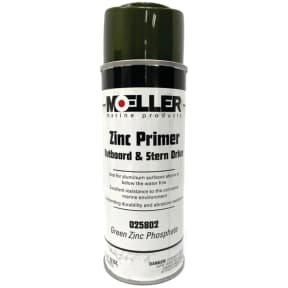



Zinc Phosphate & Cold Galvanizing Primer
Zinc Phosphate Primer - Yellow
- Steel and Iron
Availability:
Buy 6 Or More, Save 4.84%$15.74/Each
Buy 12 Or More, Save 6.78%$15.42/Each
Buy 24 Or More, Save 8.72%$15.10/Each
Description
Use either Zinc Phosphate or Cold Galvanizing on steel and iron surfaces, especially at welded joints, to protect from corrosion. These corrosive barriers conatin a high 95% concentration of zinc for maximum resistance against solvents and abrasions.
• Cold Galvanize provides a quick, inexpensive coating (think zinc paint) that can be applied on ferrous metals to help prevent rust. However, it can't match the effectiveness of true hot-dip galvanizing which is a chemical bonding between the zinc and the underlying steel, and not just a coating
• Zinc Phosphate has great anti-corrosion and adhsesion properties
Heavy on the technical side...
What is galvanizing?
Galvanizing is a process used to protect steel objects from corrosion. In the galvanizing process, the piece of steel to be protected is dipped in a bath of molten zinc at approximately 850°F.
The molten zinc chemically bonds to the steel producing a four layer, impervious barrier between the steel substrate and corrosive elements in the atmosphere. It does not allow moisture or corrosive chlorides and sulfides to attack the steel. More importantly, zinc is anodic to steel - meaning it will corrode before the steel, until the zinc is entirely consumed - thus offering protection from galvanic corrosion as well chemical corrosion.
The galvanizing process involves a succession of "dips" which include solvent cleaning the steel to remove organic materials such as grease, caustic cleaning (with hydrochloric or sulfuric acid) to remove mill scale and rust, "priming" the clean steel with a flux which promotes the reaction between zinc and steel, and finally "galvanizing" by dipping the piece in molten zinc, where the steel and zinc chemically react to form three zinc-iron intermetallic layers and one pure zinc outer layer.
The three intermetallic layers, by the way, are actually harder than the steel, and provide excellent abrasion resistance.
The thickness of the galvanizing zinc coating cannot be manipulated; it is determined by the chemistry of the steel alloy, its surface condition/characteristics, and any additional production steps such as annealing.
Trying to achieve a thicker coating by leaving the steel in the molten zinc a little longer may increase the coating thickness by a small margin, but it may also make the coating brittle - a liability.
(The galvanizing term "double dipping" can be misleading. It refers to dipping one half of an object, then turning it to dip the other half when the object is too large to fit in the zinc kettle all at once. It does not mean dipping it twice to get a thicker coating.)
The color and appearance of galvanized items may differ from manufacturer to manufacturer. The chemistry of the steel is the primary determinant of galvanized coating thickness and appearance. Cast steel produced by various steel mills has a wide variety of chemistries, thus the different coating appearances.
There are several different additives galvanizers may put in their zinc kettle to make the coating appear shiny, spangled, or matte gray. The appearance of the coating (matte gray, shiny, spangled) does nothing to change the corrosion protection of the zinc coating.
The service life of a galvanized coating can be significantly increased (up to double) by overcoating with a compatible paint - a "duplex coating".
There is no such thing as "cold galvanizing"; it is a marketing term. Cold galvanizing is used in reference to painting with zinc-rich paint, and is often done without the surface preparation, and certainly not the high temperatures necessary for good bonding of the zinc. Galvanizing by definition means a metallurgical reaction between zinc and iron to create a bond between the zinc and the steel of approximately 3600 psi. There is no such reaction when zinc-rich paints are applied and the resulting zinc-iron bond strength is only several hundred psi. Cold galvanizing is, at best, a temporary measure. It does not provide the same zinc-iron bonding, durability, abrasion resistance, or corrosion protection of hot-dip galvanizing.
Source: American Galvanizers Association; http://www.galvanizeit.org/hot-dip-galvanizing/what-is-hot-dip-galvanizing-hdg/faq#galvanizingprotectsteel
Specifications
60808282389460
739729258019
039729258010
10739729258016
10039729258015



